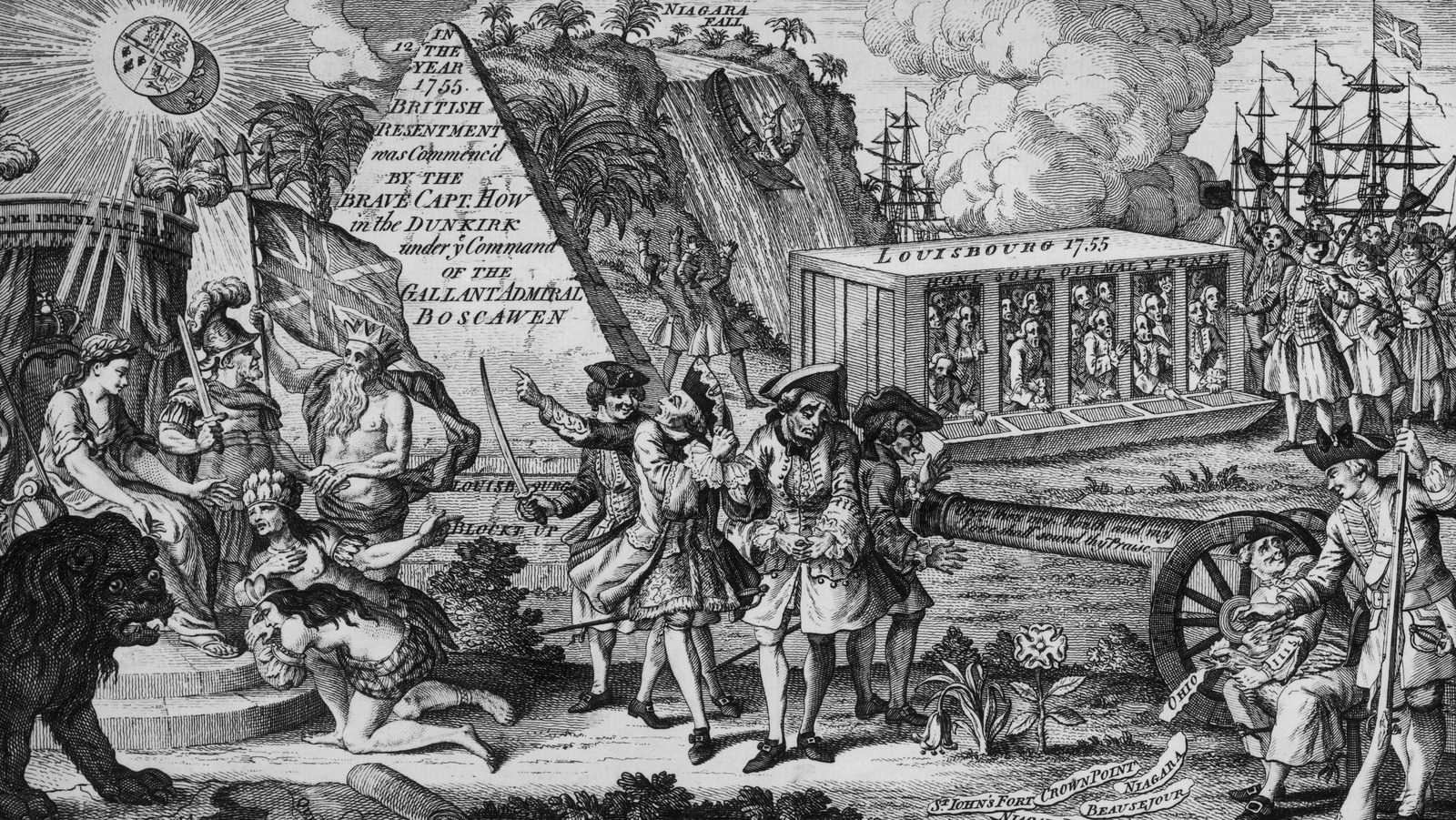
Tragic Details About The Seven Years’ War – Grunge
The Seven Years’ War was a global conflict fought between powerful empires across five continents. It was so massive that, despite its name, historians struggle to give exact dates for its beginning and end — though many agree it was fought between 1756 and 1763.
As described by History, the war was fought all over the world and it was the cumulation of many separate conflicts going on at the same time that became a part of the Seven Years’ War. The part fought in Europe can be considered an extension of the War of Austrian Succession, which ended in 1748. The portion fought in the United States, primarily between Great Britain and France, is often referred to as the French and Indian War. The French and Indian War is particularly famous, as it created the metaphorical political powder keg that exploded into the American Revolution.
Although the conflict was fought by some of the most powerful empires in the world, this brutal war devastated the lives of ordinary people living all around the world. Here are some tragic details about the Seven Years’ War.
It was a world war
 Johann Christoph Frisch/Wikimedia Commons/Public Domain
Johann Christoph Frisch/Wikimedia Commons/Public Domain
In the United States, the best-known portion of the Seven Years’ War took place in North America and was known as the French and Indian War. In reality, the conflict in the American colonies was actually just a part of a much larger, global conflict. As quoted by Crash Course, Winston Churchill once described the Seven Years’ War as the first “world war.”
In Europe, global superpowers were crashing together. As stated by Britannica, the war began because Prussia, under Frederick II the Great, had taken the province of Silesia, and Austria, led by the ruling family the Habsburgs, wanted it back. Great Britain and Hanover sided with Prussia while France and Russia sided with Austria. Their conflicts ran deeper than who would control Silesia, however, and soon the Seven Years’ War became a struggle for global dominance between the largest imperial powers in the world.
The war was fought on five continents and at sea. These empires had established colonies around the world and were competing with each other for land, trade resources, and power. As described by History, Great Britain and France famously clashed over land in North America, but the Seven Years’ War also led to fighting in the Caribbean, West Africa, and India.
The war only ended in Europe because of the death of a Tsarina
 Louis Tocqué/Wikimedia Commons/Public domain
Louis Tocqué/Wikimedia Commons/Public domain
The Treaty of Paris would eventually end the fighting in North America, but in Europe, Russia’s empress would have to die to end the war. Her death was called a miracle.
The Seven Years’ War is often considered a continuation of the War of Austrian Succession, in which Prussia was given control over the province of Silesia, previously ruled by Austria. As explained by History, this led to conflict because Russia, under Tsarina Elizabeth, felt that made Prussia too powerful. Prussia was led by Fredrick II the Great, who hoped to gain even more land.
What followed was a long, costly, and bloody war. As noted by Crash Course, death tolls were high. In some areas of Prussia, as many as 20% of citizens were killed by raiding and pillaging from the armies passing through. The cost to both sides was incredibly high, and likely would have continued for many more years, but in 1762, Tsarina Elizabeth died. As stated by Britannica, her heir was her nephew Peter III, who was actually kind of a fan of Fredrick II the Great of Prussia, and he pulled Russia out of the war. The Treaty of Hubertusburg made the end of the Seven Years’ War official, and it was signed five days after The Treaty of Paris.
There had been violence in the colonies for decades
 Ludolf Bakhuizen/Wikimedia Commons/Public Domain
Ludolf Bakhuizen/Wikimedia Commons/Public Domain
While the exact dates of the Seven Years’ War are open to debate, there is no doubt that it was preceded by decades of violence and death.
As described by the State Historical Society of North Dakota, France, Britain, and Spain had been fighting over the colonies since 1689 in the “Wars for Empire.” Just as the French and Indian War was a part of the Seven Years’ War, these earlier conflicts were also connected to the fighting going on in Europe. These included King William’s War, the War of Spanish Succession, and the War of Austrian Succession. As implied by their names, these conflicts were primarily about the ambitions of empires, not the people living in their colonies. The Seven Years’ War (known in the colonies as the French and Indian War) is considered the last of these colonial wars, and it was among the most devastating.
Conflict between imperial superpowers ravaged North America
 Hulton Archive/Getty Images
Hulton Archive/Getty Images
When the colonial empires of Europe went to war, North America was caught in the crossfire. For France and Great Britain, the war was about land, power, trade, and becoming the most powerful empire in the world. For the people of North America, particularly the Indigenous peoples whose ancestors had lived there for thousands of years, it was about trying to survive. As described by “Empires of the Atlantic World: Britain and Spain in America, 1492-1830,” the war being fought between colonial powers would change the fate of North America.
The British Empire is generally considered the winner of the French and Indian War, but the Seven Years’ War did tremendous damage to all involved. As explained by Crash Course, it is estimated that around the world about 1 million soldiers were killed. Ultimately, the French would sign a treaty agreeing to limit their activity in India, the Caribbean, and North America. That didn’t mean that British settlers were necessarily in a better position than before the war, however, because in order to survive, armies on both sides had frequently raided, sometimes leaving those on the frontier in dire straits. Native Americans had been forced into a war started on another continent by empires that were trying to claim land which had historically been theirs. After Great Britain’s victory, even more English settlers arrived, forcing more Indigenous people off of their land.
George Washington led an unprovoked attack
 Heritage Images/Getty Images
Heritage Images/Getty Images
George Washington would go on to lead the Continental Army for the United States during the Revolutionary War and become the new nation’s first president, but during the Seven Years’ War, Washington was only 22 and a highly inexperienced lieutenant colonel in the British army. His actions would spark a war.
As described by History, the heart of the conflict between France and England at this time was which of them would control the Ohio River Valley. The region was extremely valuable, and there was also competition for it between several Native American nations. One of these groups was the Mingo (sometimes called Iroquois or Seneca). Their leader was named Tanacharison, and unlike Washington, he was an experienced general. Some historians have suggested Tanacharison used his influence over Washington to encourage him to make the first move against the French for political reasons.
Although war had not been declared between Britain and France, Washington led British and Mingo forces to attack a French camp. According to the French, the camp Washington attacked was on a diplomatic mission, meaning that Washington had, in a time of peace, slaughtered diplomats, not soldiers. Washington argued that the French had placed the camp there for aggressive military reasons. One Mingo warrior who fought alongside the British claimed that it had been Washington who fired the first shot at Jumonville’s camp. Regardless, that shot triggered the beginning of the Seven Years’ War in North America.
An act of revenge escalated the war
 Three Lions/Getty Images
Three Lions/Getty Images
The French camp that Washington and his men attacked was led by Joseph Coulon de Jumonville. During the skirmish, Jumonville was injured, and as noted by the National Parks Service, he was killed by Tanacharison after the fight.
The French were furious and used the attack as fuel for their propaganda campaign against the British. As described by History, no one was as angry as Jumonville’s brother, Louis Coulon de Villiers. Villiers was also a leader in the French army, and about a month after Jumonville’s death, an attack was ordered on Washington at Fort Necessity. The army — made up of French, Huron, Odawa, and Iroquois fighters — was led by Villiers. While it was a tactical decision, many have also viewed it as Villiers’s chance to avenge his brother’s death.
As described by Trib Live, it is believed that Villiers was able to secure a French victory because of French alliances with Native American nations. Washington and his British force were unable to secure military support to defend Fort Necessity from the Native American nations in the region, and they were vastly outnumbered.
Washington misunderstood the terms of his surrender
 Washington Irving Henry Bryan Hall John McNevin/Wikimedia Commons/Public domain
Washington Irving Henry Bryan Hall John McNevin/Wikimedia Commons/Public domain
The French and Indian War may have been just one region’s part in a global conflict, but there were many different groups who spoke many different languages involved. More than once attempts to communicate went awry with devastating consequences. After George Washington’s defeat at Fort Necessity, he was forced to negotiate a surrender. As noted by History, the fact that Washington could not speak French made this extremely difficult.
To communicate, the French army leader Louis Coulon de Villiers and Washington required a translator. Unfortunately, poor translation led Washington to accept terms of surrender that were far worse than he likely would have accepted if he had understood. One of the terms was that he had to accept personal responsibility for the death of Villiers’ brother, Joseph Coulon de Jumonville, which Washington almost certainly would not have agreed to intentionally. This translation error became a massive propaganda victory for the French, which in turn led the British to assemble an enormous military force that they sent to North America.
It led to a massive forced deportation
 Henri Beau/Wikimedia Commons/Public domain
Henri Beau/Wikimedia Commons/Public domain
The Seven Years’ War may have been a conflict between European empires, but it had devastating consequences for people all over the world. For French settlers in Nova Scotia, known as Acadians, it would be a major turning point. As described by History, after the French victories at the beginning of the French and Indian War, particularly George Washington’s defeat at Fort Necessity, British colonists were getting nervous. The British governor of Nova Scotia, aware that the French had the support of many of the local Native American nations, feared that if they had to fight the French, they would lose. There was a significant population of French settlers in Nova Scotia, and the governor was concerned that they might support the French if fighting broke out. What followed was a massive forced deportation of thousands of people from Nova Scotia.
As described by The University of Maine, beginning in 1755 about 7,000 Acadians were forced out of the region. Their communities, farms, and homes were destroyed, while the people were captured and forcibly sent back to France or other British colonies.
The war forced Indigenous peoples to choose sides
 Print Collector/Getty Images
Print Collector/Getty Images
The land in the Ohio River Valley and the rest of North America that the French and the British were fighting over was already inhabited by Native American nations. As described by Crash Course, many of the Indigenous people used the fact that France and England were in competition with each other to their advantage before the outbreak of the Seven Years’ War. While the British and the French focused on fighting each other, the Native Americans could survive. While the British were always hoping to expand, they couldn’t take too much of the land that Indigenous peoples lived on without conflict and they also had to avoid encroaching on territory the French claimed.
This delicate system would break down when open warfare began. As described by Oneida Nation, with the French and British actively fighting, Indigenous peoples were forced to choose sides in a war between two empires looking to colonize their land. After the British ultimately won the French and Indian War, massive amounts of British settlers arrived in the Americas. Without the threat of the French keeping British colonies from expanding, the Native American nations were pushed off their land.
The British and French used Indigenous people to fight their war
 John Henry Walker/Wikimedia Commons/Public domain
John Henry Walker/Wikimedia Commons/Public domain
Although Britain and France were global superpowers, neither side had a chance in pushing the other out of North America without the assistance of Native American nations. As detailed by Trib Live, alliances with Indigenous peoples were often the difference between winning or losing battles in the North American Seven Years’ War. After the war, however, these alliances and treaties were disregarded and Native American nations were still pushed off of their land despite the help they had provided.
In general, most Native American nations, including the Algonquin, Lenape, Ojibwa, Ottawa, and Shawnee, sided with the French (per Oneida Nation). This is likely because the French were primarily looking to trade and hunt in North America, while the British were looking to move settlers onto the land. Another possible motivation explored by Crash Course is that the predominantly Catholic French had sent many missionaries to attempt to convert the Indigenous people, so they were more likely to have learned the languages of the native peoples than the British. As stated in Britannica, the British built on a lapsed alliance with the Iroquois Confederacy that was referred to as The Covenant Chain. This was a mutual agreement between the British government and the Iroquois Confederacy stating that the land that the British had colonized was British, and all the land between the Mississippi and Hudson Rivers belonged to the Iroquois.
Miscommunication may have been responsible for a deadly massacre
 Theresa Lauria/Shutterstock
Theresa Lauria/Shutterstock
There was a major British garrison called Fort William Henry located at Lake George. As described by the Fort William Henry Museum, it was located in a pivotal strategic location that kept waterways between New York City and Montreal under British control. In 1757, thousands of French soldiers and their Native American allies surrounded the fort, preventing anyone from going in or out. Ultimately, the British were forced to surrender. The French and British negotiated a deal in which the British soldiers would be allowed to leave unharmed as long as they gave up the fort. However, after the British left the safety of Fort William Henry, they were attacked and it is believed around 200 men were killed. The wounded men who had been left behind in the fort were slaughtered.
Exactly what happened is unknown, but one theory is that there was a language barrier between the French and their Native American allies and that the Indigenous people working with the French were unaware that any deal had been negotiated.
Disease was deadlier than the fighting
 Benjamin West/Wikimedia Commons/Public domain
Benjamin West/Wikimedia Commons/Public domain
The fighting itself was devastating, but shockingly, the majority of the soldiers who died were killed not by warfare, but by horrendous outbreaks of disease. As stated by Crash Course, by the fall of 1761, around 1,000 British soldiers had been killed in combat, while 5,000 had been killed by various illnesses spreading through the ranks.
As noted by an article in “Bulletin of the History of Medicine” from Johns Hopkins University Press, multiple different deadly viruses were killing soldiers on all sides of the Seven Years’ War. Some of these epidemics were deadly enough to wipe out entire military forces. Some of the worst medical disasters experienced by soldiers in the Seven Years’ War included Yellow Fever, a virus that spreads via mosquito bites (per the CDC); scurvy, a severe vitamin C deficiency that often affected people at sea for long periods of time; and smallpox, a deadly and extremely contagious virus.
Disease hit Indigenous people hardest
 Stocksnapper/Getty Images
Stocksnapper/Getty Images
The infectious diseases which decimated the British and French forces during the Seven Years’ War were even more deadly to Native American nations because they had no immunity. As noted by History, some believe that European settlers gave the Native Americans smallpox intentionally as a form of biological warfare. There is at least one documented example of colonists attempting to intentionally infect Indigenous populations, but regardless of whether settlers and trappers meant to or not, the arrival of Europeans certainly led to devastating outbreaks in Native American nations.
As described by the “Encyclopedia of North Carolina,” conditions like smallpox were devastating for Indigenous people of North America. One example of this was the enormous damage done to the Cherokee population in North America. The Cherokee population had been decimated by smallpox, likely starting with their very first contact with European settlers. It is believed that as many as 50% of Cherokee people had been killed when they supported the British in an earlier conflict with the Spanish, and the epidemic spread through the Cherokee nation again during the French and Indian War.
Even though the British won the war, they would lose the colonies
 Print Collector/Getty Images
Print Collector/Getty Images
Ultimately, the French and Indian War came to an end with a British victory, and the North American theater of the Seven Years’ War was over. As noted by the Office of the Historian, the Treaty of Paris gave Great Britain control of all of France’s colonies in mainland North America, making Great Britain the only global superpower claiming the continent. The war had cost thousands of British, French, and Native American lives. But even though Great Britain seemed to have won, in 20 years, the British would lose control of North America, too.
As described by History, Great Britain had gone seriously into debt to win the French and Indian War. In order to make some of their money back, they instituted taxes on common items like stamps and tea in their North American colonies. These would enrage the colonists, who famously argued that because they had no representation in the British government they were suffering “taxation without representation.” This conflict soon escalated into the American Revolution, and Great Britain lost control of the territory that they had fought a bloody war to keep.











































































